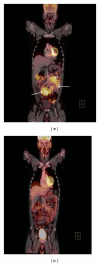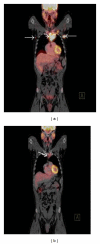18-Fluorodeoxyglucose Positron Emission Tomography/Computed Tomography in the Management of Aggressive Non-Hodgkin's B-Cell Lymphoma
- PMID: 22474590
- PMCID: PMC3313577
- DOI: 10.5402/2012/456706
18-Fluorodeoxyglucose Positron Emission Tomography/Computed Tomography in the Management of Aggressive Non-Hodgkin's B-Cell Lymphoma
Abstract
18-Fluorodeoxyglucose (FDG-PET/CT) is an established imaging modality that has been proven to be of benefit in the management of aggressive B-cell non-Hodgkin's lymphoma, such as diffuse large B-cell lymphoma and advanced stage follicular lymphoma. The combination of anatomic and functional imaging afforded by FDG-PET/CT has led to superior sensitivity and specificity in the primary staging, restaging, and assessment of response to treatment of hematological malignancies when compared to FDG-PET and CT alone. The use of FDG-PET/CT for posttreatment surveillance imaging remains controversial, and further study is needed to ascertain whether this modality is cost effective and appropriate for use in this setting.
Figures





References
-
- Flowers CR, Armitage JO. A decade of progress in lymphoma: advances and continuing challenges. Clinical Lymphoma, Myeloma and Leukemia. 2010;10(6):414–423. - PubMed
-
- Jemal A, Siegel R, Xu J, Ward E. Cancer statistics, 2010. CA Cancer Journal for Clinicians. 2010;60(5):277–300. - PubMed
-
- Cronin CG, Swords R, Truong MT, et al. Clinical utility of PET/CT in lymphoma. American Journal of Roentgenology. 2010;194(1):W91–W103. - PubMed
LinkOut - more resources
Full Text Sources

